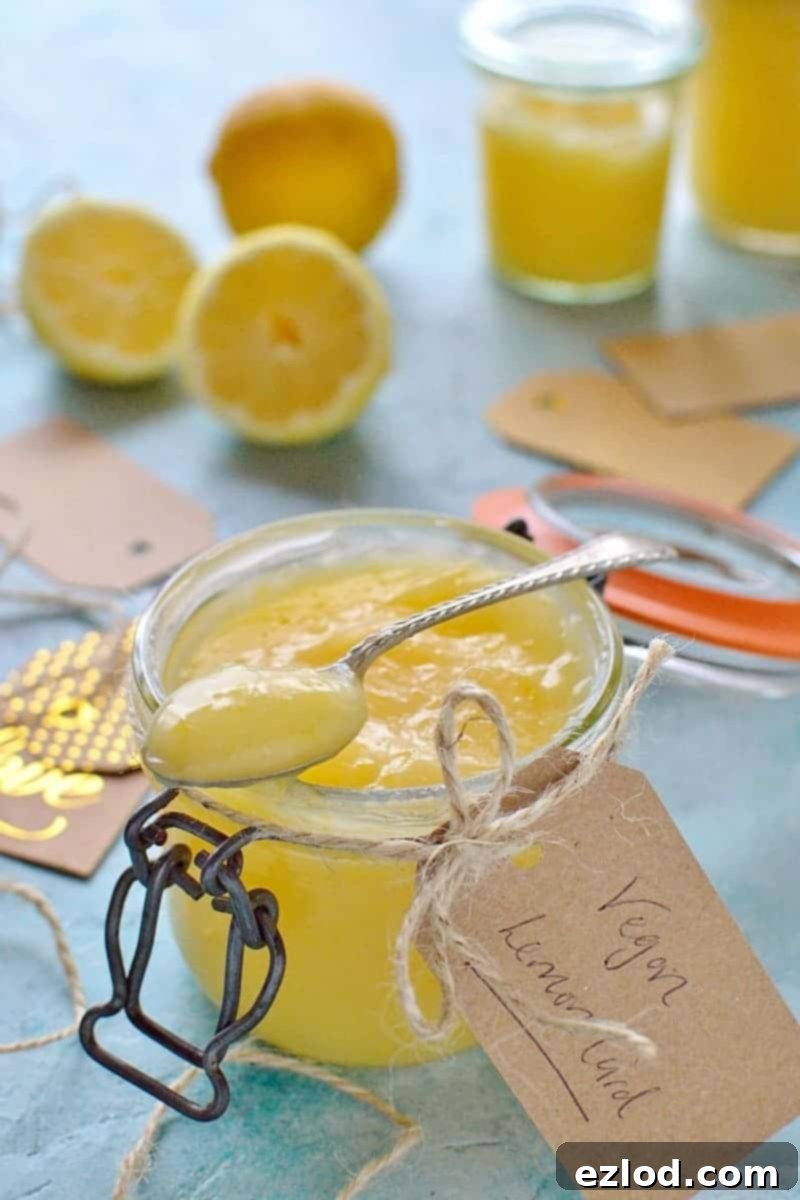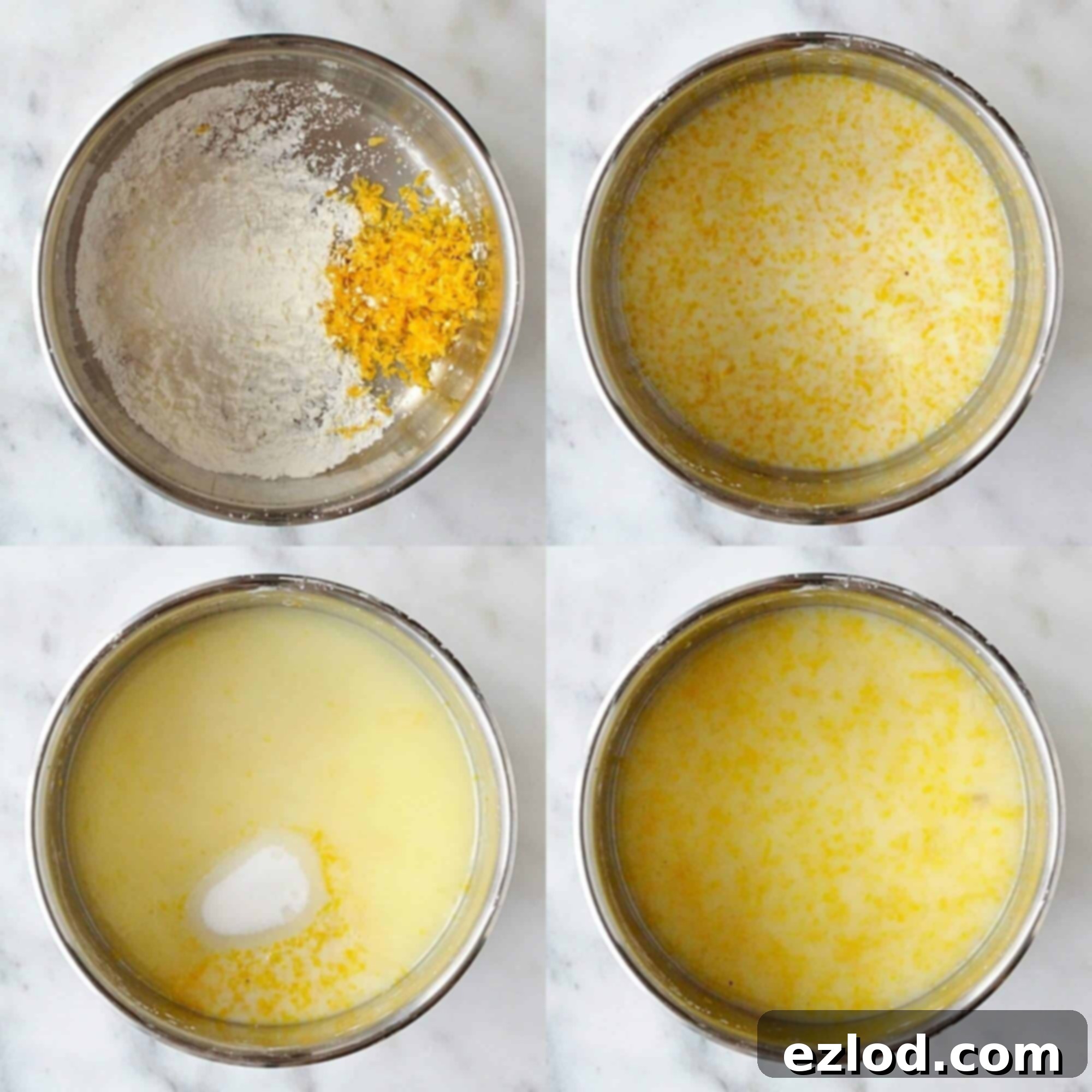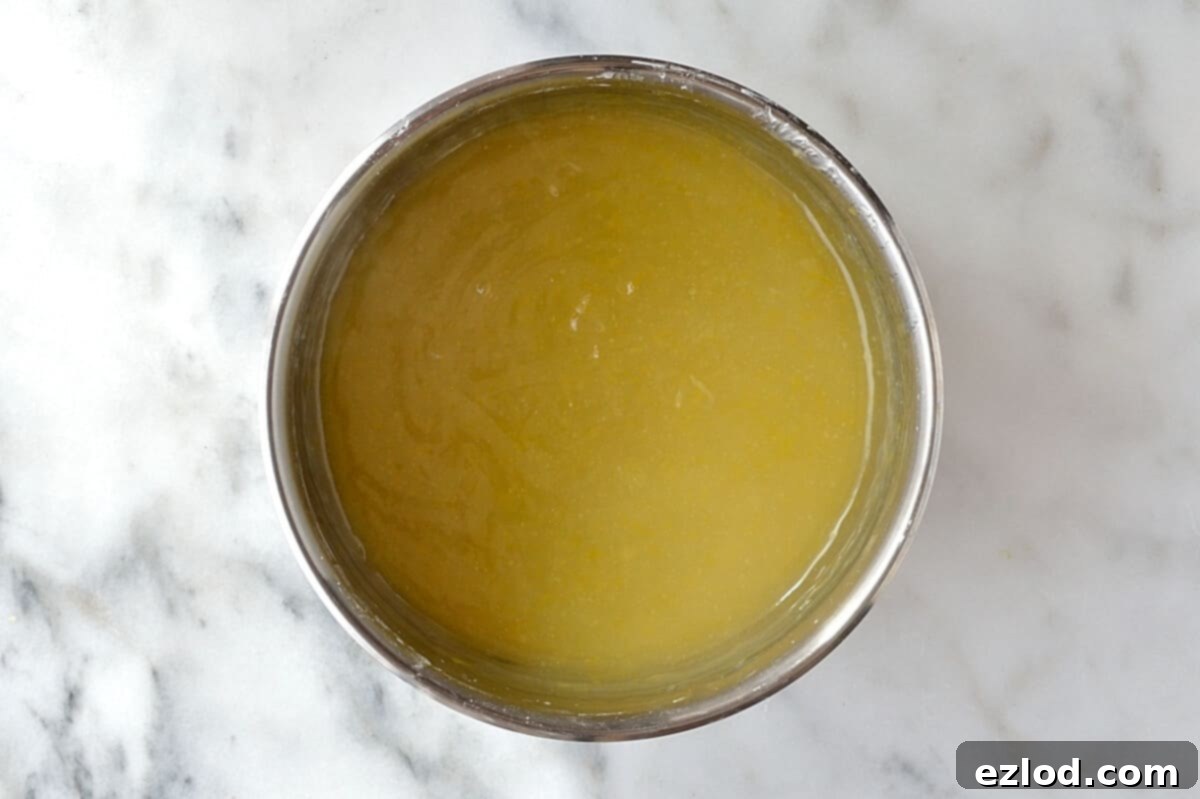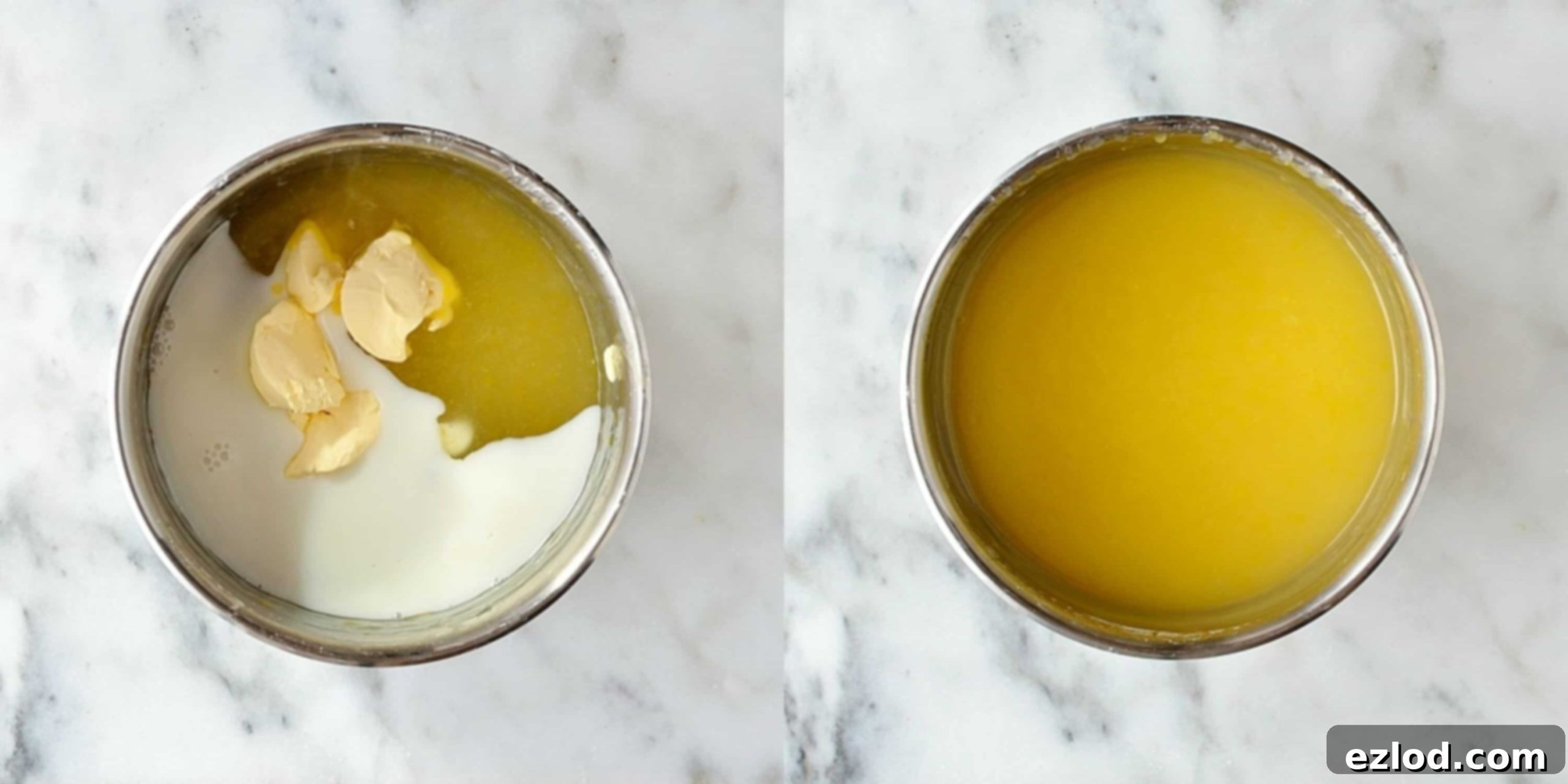Easy Homemade Vegan Lemon Curd: Bright, Creamy & Ready in Under 10 Minutes
Discover the secret to a perfectly sweet, intensely tangy, and lusciously creamy lemon curd that’s entirely vegan, egg-free, and dairy-free. This incredible spread comes together in less than ten minutes, offering all the vibrant flavor you love without any animal products!
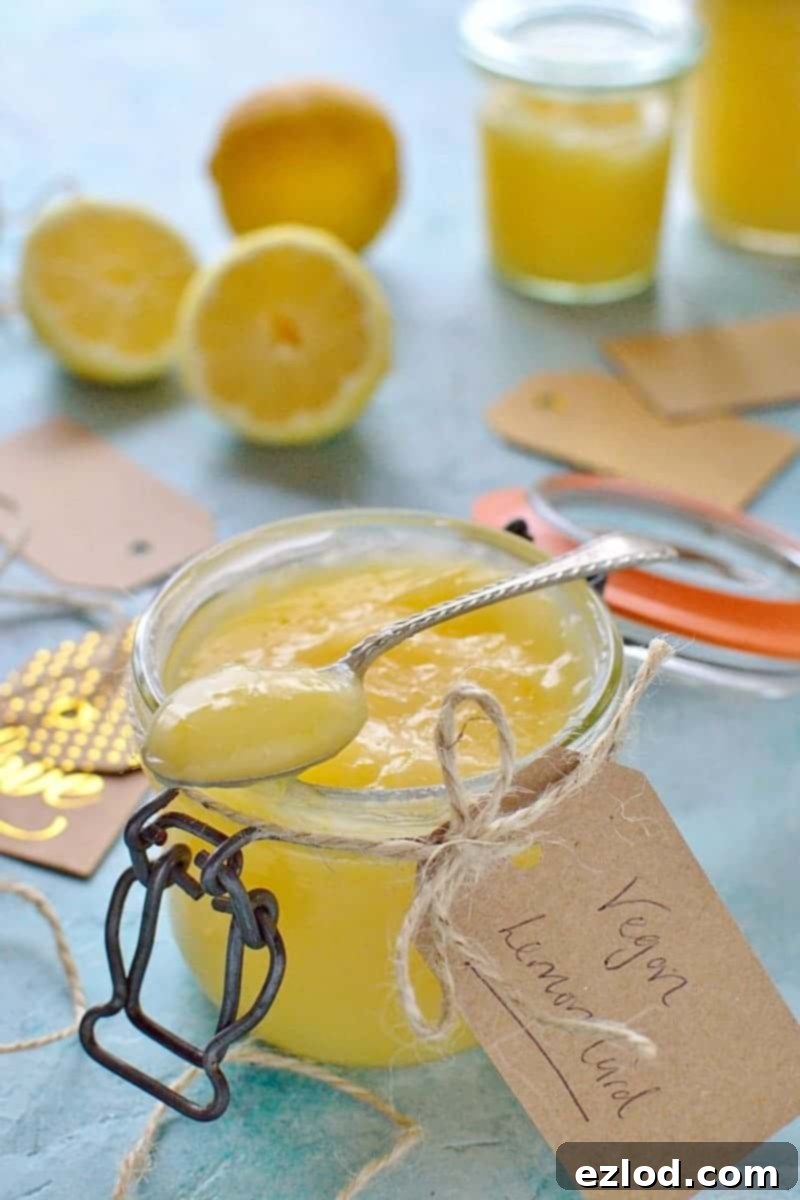
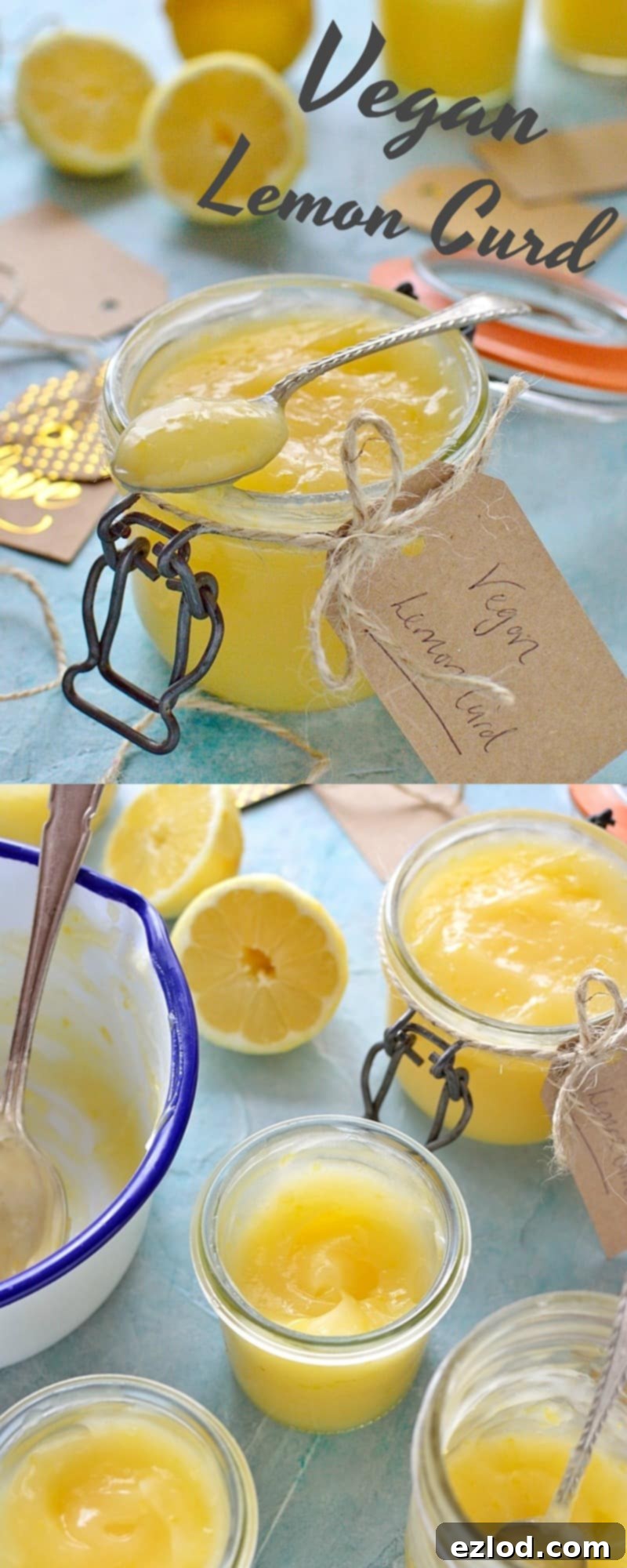
There’s something truly magical about lemon curd – that perfect balance of sweet and tart, with an impossibly smooth and creamy texture. For years, I enjoyed traditional lemon curd, often incorporating it into various baked goods and desserts. However, as I’ve embraced more plant-based cooking in my own kitchen, I knew I needed a vegan version that could live up to the classic. And let me tell you, this vegan lemon curd not only meets but often exceeds expectations, proving that you don’t need eggs or butter to achieve a truly spectacular result.
My journey towards more plant-based eating was influenced by a desire to reduce dairy consumption, particularly for health reasons experienced by my partner, Damian. This shift inspired me to experiment extensively with vegan recipes, discovering innovative ways to recreate beloved classics. While I’ve long been vegetarian, diving deeper into veganism has opened up a whole new world of culinary possibilities, and this lemon curd recipe is a shining example of those delicious discoveries. Expect to find many more exciting vegan creations here on the blog, designed to be delicious, accessible, and nourishing for everyone!
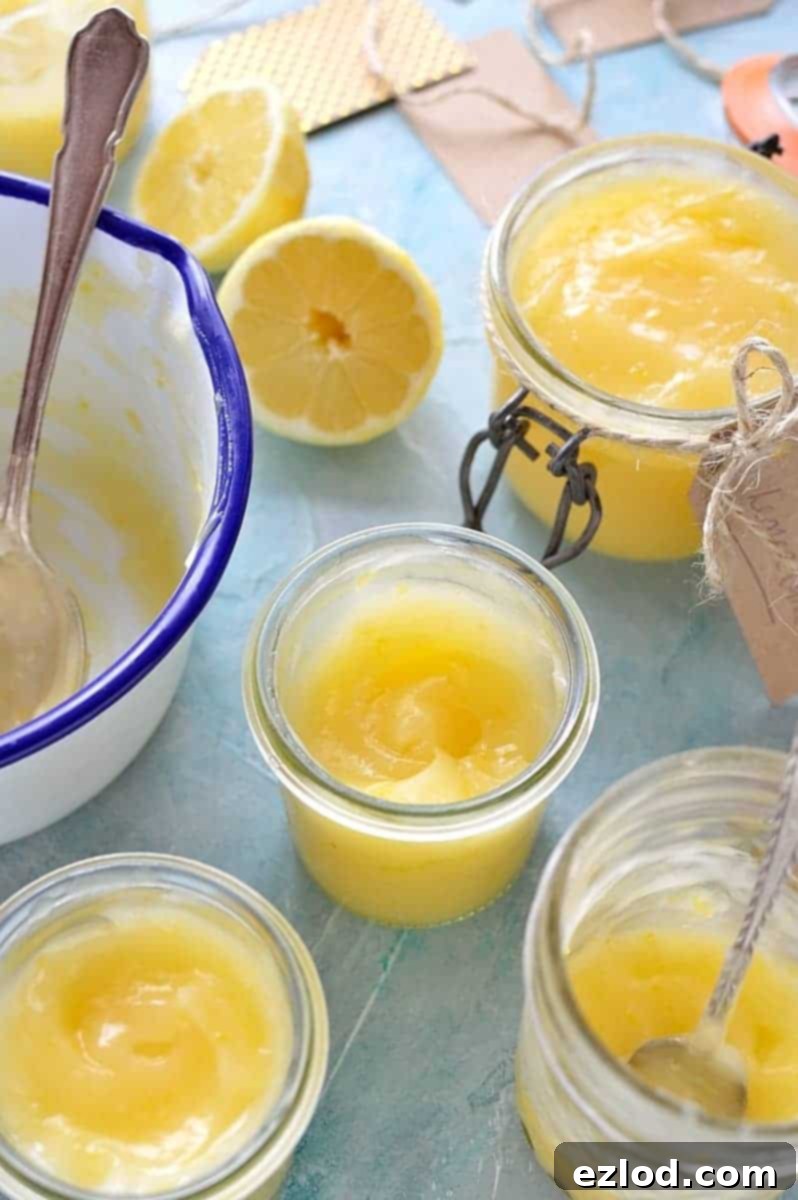
Why This Vegan Lemon Curd Will Be Your New Favorite
You might be wondering, “Can vegan lemon curd really be as good as the traditional kind?” The answer is a resounding YES! This recipe defies expectations by delivering all the creaminess, richness, and intense lemon flavor of its conventional counterpart, all while being completely egg-free and dairy-free. What’s even better is that it’s often quicker and far simpler to prepare, eliminating the finicky tempering of eggs and the risk of scrambled-egg texture that can sometimes occur with traditional recipes.
One of the greatest advantages of this recipe is its incredible speed and ease. The entire process, from gathering ingredients to having a warm, luscious curd ready to chill, takes less than ten minutes of active cooking. We achieve that wonderfully thick, luxurious consistency using cornflour (also known as cornstarch) instead of eggs. This clever substitution means there’s no need to worry about accidentally cooking your eggs too much or ending up with anything less than a perfectly smooth and creamy curd. This simplifies the process immensely, making it approachable for even novice cooks or those short on time.
Furthermore, you won’t need to hunt down obscure or expensive ingredients. This recipe relies on basic pantry staples that are now widely available in most supermarkets. Fresh lemons are key for that vibrant flavor, alongside granulated sugar, water, cornflour, unsweetened almond milk (or your preferred unsweetened plant-based milk like soy milk), and a good quality vegan spread or refined coconut oil. These days, plant-based alternatives are so ubiquitous that you’ll likely find everything you need on your regular grocery run, making this a convenient and delightful recipe for anyone to try.
The Incredible Versatility of Vegan Lemon Curd
Once you taste this vegan lemon curd, you’ll find it utterly irresistible. Despite its potential to last for a couple of weeks when stored properly in the fridge, it rarely makes it past a few days in my household! Its vibrant flavor and luxurious texture make it incredibly versatile for both sweet and savory applications. It’s a fantastic staple to have on hand for quick breakfasts, elegant desserts, or simply a spontaneous sweet craving. Here are just a few delicious ways to enjoy it:
- Classic Spreads: Elevate your morning routine by spreading it generously on warm toast, fluffy English muffins, or freshly baked scones. It’s a delightful alternative to jam or marmalade.
- Dessert Fillings: This curd makes an exquisite filling for a variety of baked goods. Use it in cakes, cupcakes, tarts, or even delicate macarons. Imagine creating a show-stopping vegan lemon meringue pie with a light, airy aquafaba meringue!
- Fruity & Creamy Pairings: Swirl a dollop into your favorite dairy-free yogurt or vegan ice cream for an instant flavor and texture boost. It also pairs wonderfully with fresh berries or a fruit salad.
- Pancakes & Crepes: Drizzle it generously over stacks of light and airy vegan pancakes or delicate crepes for a sophisticated and zesty brunch treat that’s sure to impress.
- Unique Desserts: Beyond pies and tarts, use it to top a vegan pavlova (made with aquafaba meringue and coconut whipped cream) for an elegant and refreshing dessert that’s perfect for any occasion.
- Directly from the Jar: For the ultimate, unapologetic indulgence, grab a spoon and enjoy it straight from the jar. It’s truly that good – we won’t judge!
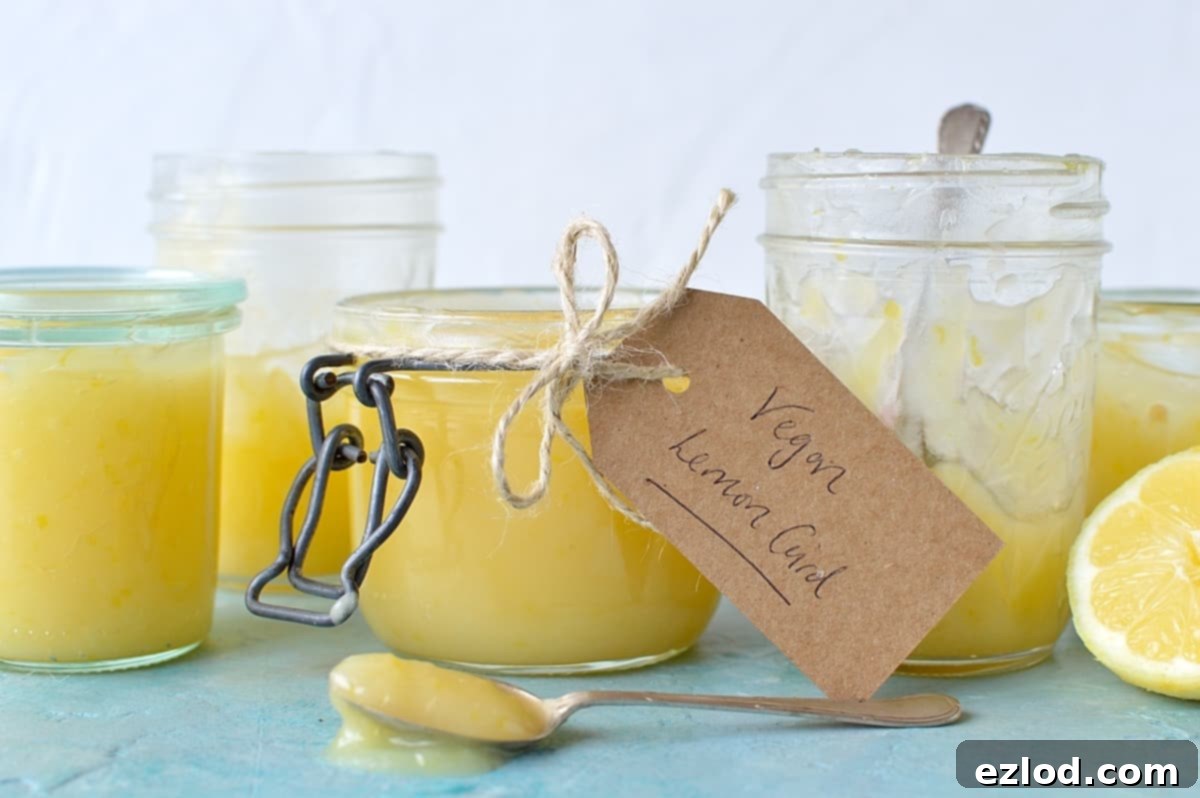
Making Your Own Vegan Lemon Curd: A Simple Guide
Crafting this delightful vegan lemon curd is surprisingly straightforward, especially since we bypass the complexities of egg-based recipes. The key to success is to follow the steps carefully and use precise measurements. For the best, most consistent results, I always recommend using a digital scale for gram measurements rather than relying solely on cup conversions. This level of accuracy is a baker’s best friend and ensures a perfect consistency and flavor every time you make it.
Essential Ingredients & Their Roles:
- Lemon Zest & Juice: These are undeniably the stars of our vegan lemon curd. Always use fresh, organic lemons for the most vibrant, aromatic flavor. The zest contains essential oils that provide a deep lemon aroma, while the juice delivers the characteristic bright, tangy tartness.
- Cornflour (Cornstarch): This is our magic plant-based thickener, effectively replacing eggs in traditional curd recipes. It’s crucial for achieving that signature creamy, smooth, and gel-like texture without any eggy flavor or the risk of curdling.
- Water: Used initially to create a smooth slurry with the cornflour, preventing lumps from forming when combined with other liquids. This step is essential for a silky-smooth finished product.
- Granulated Sugar: Essential for balancing the intense tartness of the lemons. It also contributes to the curd’s overall smooth texture and helps achieve that desired glossy finish.
- Unsweetened Almond Milk (or Soy Milk): Adds a beautiful creaminess and helps to achieve the perfect spreadable consistency. Ensure you use an unsweetened variety to have full control over the curd’s sweetness level.
- Vegan Spread (Butter Alternative) or Coconut Oil: This ingredient contributes a lovely richness, a smooth mouthfeel, and a desirable sheen to the curd, effectively mimicking the role of traditional butter in classic recipes. Choose a good quality, neutral-flavored vegan spread or refined coconut oil for the best results.
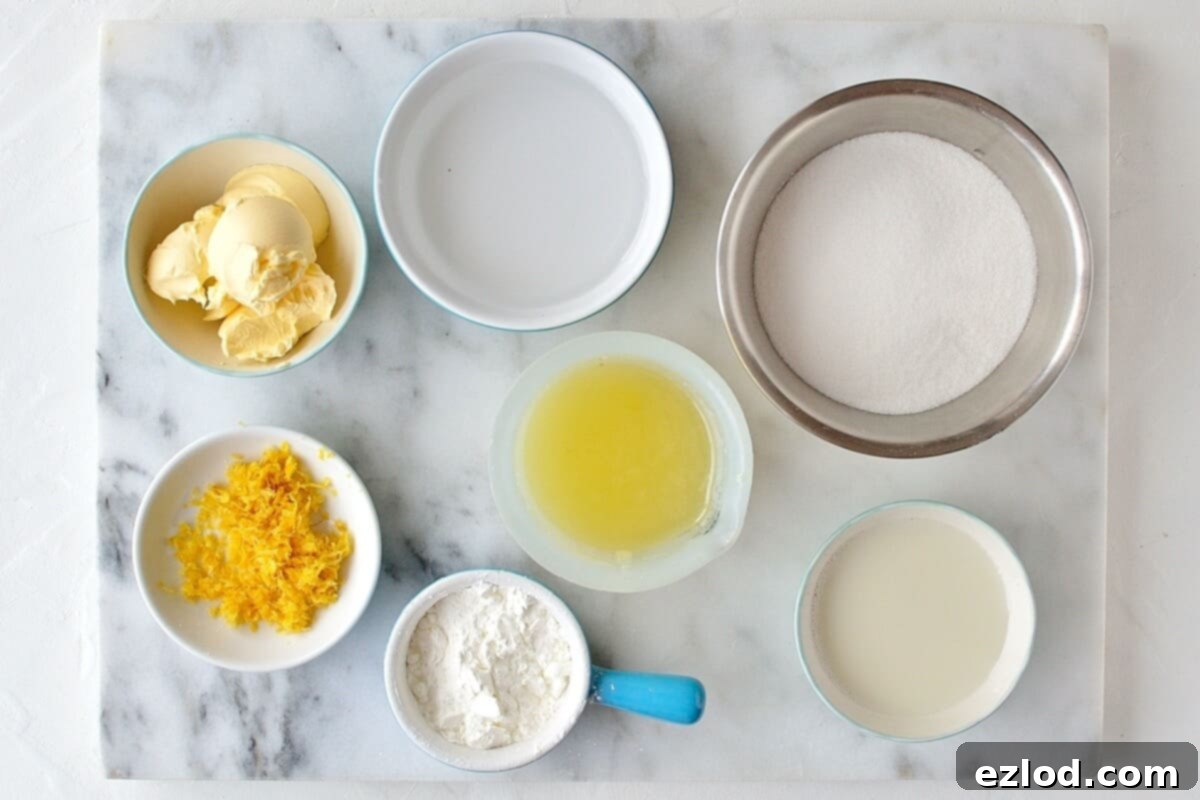
Step-by-Step Instructions:
- Prepare the Cornflour Paste: In a non-reactive saucepan (stainless steel is ideal to prevent any metallic flavors from reacting with the lemon), place the cornflour. If you’re using lemon zest (highly recommended for deep flavor, but omit for an ultra-smooth curd), add it here. Gradually pour in the water, whisking continuously and vigorously until you have a completely smooth, lump-free paste. This initial mixing is crucial for a perfectly silky curd.
- Combine Wet Ingredients: Once the cornflour paste is smooth, whisk in the fresh lemon juice and the granulated sugar until all ingredients are thoroughly combined. The mixture will still be quite thin at this point, resembling lemonade.

- Heat and Thicken the Curd: Place the saucepan over a medium-low heat. It’s important to stir constantly with a whisk or rubber spatula as the mixture heats up. Continue stirring until the sugar has fully dissolved and the curd begins to thicken noticeably. It should transform into a very thick, pudding-like consistency, easily coating the back of a spoon. This process usually takes about 5-7 minutes. Be patient and keep stirring to prevent any sticking or burning at the bottom of the pan.

- Achieve Creaminess and Gloss: Once the curd has reached the desired thickness, reduce the heat to low. Stir in the unsweetened almond milk and your chosen vegan spread (or coconut oil). Continue to stir until the vegan spread is completely melted and fully incorporated, ensuring a smooth, homogeneous, and glossy finish. Immediately remove the pan from the heat to prevent overcooking the cornflour.

- Jar and Chill for Setting: Carefully pour the hot lemon curd into clean, and preferably sterilized, jars. Fill them almost to the top, leaving a small headspace. Seal them tightly and allow them to cool completely at room temperature before transferring them to the refrigerator. The curd will continue to set and firm up significantly as it chills overnight, developing its full, rich flavor and perfectly creamy texture. Once chilled, store in the refrigerator and use within a couple of weeks.
How to Sterilise Jars for Optimal Storage
For the best shelf life and to prevent spoilage, it’s highly recommended to store your vegan lemon curd in properly sterilised jars. Sterilising jars is a simple yet crucial process that helps eliminate any bacteria or contaminants, ensuring your delicious curd stays fresh, safe, and delicious for longer. Here’s a reliable method for effective jar sterilisation:
- Preheat Oven: Just before you begin the lemon curd recipe, preheat your oven to 140°C (275°F / Gas Mark 1).
- Wash Thoroughly: Wash your glass jars and their lids meticulously in hot, soapy water. Use a bottle brush or sponge to ensure all corners and threads are perfectly clean.
- Rinse Well: Rinse them thoroughly under hot running water to remove all soap residue. Do not dry them with a cloth, as this can reintroduce bacteria.
- Prepare for Oven: Place the clean, wet glass jars on their sides on a clean baking tray. Position the metal lids (avoid plastic-lined lids unless they are specifically stated as heat-proof) upside-down on the same tray.
- Sterilise and Keep Warm: Carefully place the tray in the preheated oven. Leave the jars in the oven for at least 15-20 minutes, or until they are completely dry and heated through. Keeping the jars hot is critical for the next step.
- Fill Carefully and Safely: When your curd is ready and still hot, carefully remove the hot jars from the oven (always use thick oven mitts!). Immediately pour the hot lemon curd into the hot jars. It is absolutely essential to pour hot liquid into hot jars (and conversely, cold into cold) to prevent thermal shock, which can cause the glass to crack or shatter.
- Seal and Cool: Place the lids on tightly and leave the filled jars to cool completely at room temperature before transferring them to the refrigerator. This gradual cooling helps create a good seal.
Storage and Longevity Tips
This homemade vegan lemon curd, when properly stored in sterilised jars in the refrigerator, will typically keep well for up to two weeks. While it’s unlikely to last that long given its utterly addictive nature, it’s good to know its reliable shelf life!
- Refrigeration is Key: Always store the curd in the refrigerator immediately after it has cooled. Its ingredients are perishable, and chilling helps maintain its freshness, flavor, and creamy texture.
- Natural Separation: You might notice a slight separation or a thin layer of liquid forming on top after a few days in the fridge. This is completely normal for egg-free curds thickened with cornflour and is nothing to worry about. Simply give it a good stir with a clean spoon before serving to restore its creamy, smooth consistency.
- Freezing for Longer Storage: For extended storage, vegan lemon curd can be frozen. Pour it into freezer-safe containers or jars, ensuring you leave a little headspace (about an inch) to allow for expansion. It can be frozen for up to 2-3 months. To use, simply thaw the frozen curd in the refrigerator overnight and give it a good stir before serving.
Creative Variations and Flavor Enhancements
While classic lemon curd is a masterpiece on its own, this versatile vegan recipe can be easily adapted to create other exciting and equally delicious flavors. Don’t be afraid to experiment!
- Vegan Coconut Lime Curd: Simply swap out the lemon juice and zest for fresh lime juice and zest. For an extra tropical twist, you can also incorporate a tablespoon or two of full-fat coconut milk at the final step.
- Vegan Mango Curd: Reduce the lemon juice slightly (or replace some with water) and blend in some ripe, smooth mango puree at the final stage for a wonderfully tropical and sweet curd. You may need to adjust the amount of sugar based on the natural sweetness of your mangoes.
- Vegan Blood Orange Curd: Replace the lemons with blood oranges for a stunning, vibrant color and a slightly sweeter, often less tart flavor profile. The method remains largely the same.
- Ginger Zest: For a subtle spicy kick, add a small amount (around ½ to 1 teaspoon) of finely grated fresh ginger along with the lemon zest at the beginning of the recipe.
- Vanilla Bean Infusion: For an added layer of warmth and sophistication, infuse your curd with vanilla. You can scrape the seeds from half a vanilla bean pod and add them with the lemon zest, or stir in a teaspoon of good quality vanilla extract at the very end.
If you’re eager to try other delicious plant-based curds and expand your repertoire, be sure to explore my recipes for vegan coconut lime curd, vegan mango curd and vegan blood orange curd. They are just as easy to make and equally delightful!
This vegan lemon curd recipe was originally developed and proudly featured for DIYs, a fantastic online resource brimming with creative craft and recipe ideas. Check them out for more inspiration and exciting projects!
If you tried this incredible vegan lemon curd recipe, I’d absolutely love to see your delicious creations! Please tag @domestic_gothess on Instagram and use the hashtag #domesticgothess so I can admire and share your wonderful results!
*All images and content on Domestic Gothess are copyright protected. If you want to share this recipe then please do so by using the share buttons provided. Do not screenshot or post the recipe or content in full.*
Vegan Lemon Curd Recipe Card

Vegan Lemon Curd
Ingredients
- 30 g (3 Tbsp) cornflour (cornstarch)
- 100 ml (⅓ cup + 1 Tbsp) water
- finely grated zest of 2 large lemons (optional for an ultra-smooth curd, but highly recommended for intense flavor)
- 200 ml (½ cup + ⅓ cup) fresh lemon juice (from about 4 large or 5-6 small lemons)
- 200 g (1 cup) granulated sugar
- 60 ml (¼ cup) unsweetened almond milk (or unsweetened soya milk)
- 70 g (4 Tbsp) vegan spread (I use Flora Original, or substitute with refined coconut oil for a firmer set)
Instructions
-
In a non-reactive saucepan (like stainless steel), place the cornflour and lemon zest (if using). Gradually whisk in the water until you have a completely smooth paste with no lumps. Then, whisk in the fresh lemon juice and granulated sugar.
-
Place the pan over a medium-low heat. Stir continuously with a whisk or rubber spatula until the sugar has fully dissolved and the mixture begins to thicken significantly, reaching a very thick, pudding-like consistency that coats the back of a spoon. This should take about 5-7 minutes.
-
Turn the heat down to low. Add the unsweetened almond milk and vegan spread (or coconut oil). Stir until the spread is completely melted and fully incorporated, resulting in a smooth and glossy curd. Remove from heat immediately to prevent overcooking.
-
Carefully pour the hot lemon curd into two clean (and preferably sterilized) jars. Seal them tightly and allow them to cool completely at room temperature before refrigerating. The curd will firm up considerably as it chills. Store in the refrigerator for up to two weeks. If separation occurs after a few days, simply stir well to recombine.
Notes
